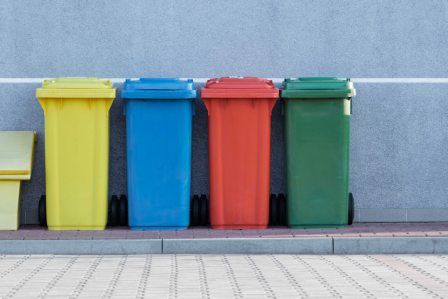
 Americans produce over four pounds of garbage per person each day, according to the Environmental Protection Agency. This adds up to 29 pounds per week and 1,600 pounds a year. What happens to all that trash?
Americans produce over four pounds of garbage per person each day, according to the Environmental Protection Agency. This adds up to 29 pounds per week and 1,600 pounds a year. What happens to all that trash?
Most garbage haulers dump the garbage at a transfer station. Recyclables are sorted mainly by hand, on a conveyor belt. Plastics, particularly numbers 1-7, are crushed and baled by a “Wall-e” type machine that produces perfect cubes. These cubes are sold on the commodities market for about 60 cents per pound. This plastic is reprocessed using high temperatures that burn off most food particles and paper labels.
Glass is more difficult to recycle, and there is little call for it on the commodities markets. Industry is switching to lighter packaging to save money on shipping costs and replacing glass bottles with plastic. Most recycling facilities actually have to pay an average of $25 per ton to ship glass to a reprocessing facility.
Aluminum is one of the most recycled items in the garbage, with about 35 percent of all cans on the market living a second or third life. “It takes about 12 ounces of energy to make a single 12 ounce can,” notes recycling facility manager Bill Cutler. “Never, ever throw one away!”
Polystyrene foam is considered a contaminant in most recycling facilities as it often winds up in garbage but cannot be recycled. Contrary to popular belief, it is not the bulk clogging up our landfills, nor is disposable diapers. The bulk in most landfills is paper, especially newspapers that could be recycled.
This little-known fact was discovered by an archaeologist who excavates landfills. William L. Rathje, professor emeritus at the University of Arizona, dug up three landfills in Arizona, California and Illinois. His team discovered newspapers from the late 1970s that were still readable, green grass clippings, a T-bone steak with lean and fat and five hot dogs, all fairly fresh.
Rathje exposed the fact that organic matter doesn’t really biodegrade in landfill conditions. “Well-designed and well-managed landfills, in particular, seem to be far more apt to preserve their contents for posterity than to transform them into humus or mulch,” says Rathje. “They are not vast composters; rather, they are vast mummifiers.”
A byproduct of landfills is methane and carbon dioxide gases, which contribute to climate change. These gases could be used to generate electricity or heat, instead. There are 400 landfill gas energy projects scattered across the United State.
“It’s too late to do anything about reducing waste by the time it gets to the landfill,” notes Cutler, who diverted over 5,000 pounds of recyclables from the waste stream last year. “We need to let go of the disposable mentality,” he notes. “If you don’t absolutely need it, don’t buy it!”
How to Reduce Household Waste
Compost! Separate organic materials like leaves, grass clippings, vegetables peels and scraps, and keep them in a composter or pile in the backyard.
Precycle! Purchase items with the least amount of packaging. Buy items that can be recycled, like Tom’s toothpaste, the only toothpaste tube that can be recycled.
Guerrilla Recycle! Take apart the layers of pet food bags and discard the plastic inner liner. Over a pound of paper can be recycled from one pet food bag!
Skip the juice box! Items in packaging that combines paper with metal or plastic like juice boxes, milk cartons, paper bags lined with foil or bubble wrap mailers are all unrecyclable.
Skip the disposables! Use real cups, plates and napkins at your next party, and wash them instead. If it is a large party, budget for a cleaning service or find a caterer who uses real dishes.
If you have a lot of old stuff to clear out of your home and can’t afford the time and effort to recycle everything, call a service to do it for you. For a fee, a company will clear out anything and everything you no longer want, and will recycle as much of it as possible.
Aaron Fastman, manager of the 1-800-GOTJUNK in Williston, Vermont, says that they are unique in that many other “haulers” don’t recycle. “We do all the donating and recycling for you, and we know what items various places will accept.” Locally, Fastman says the company recycles/donates to organizations including ReSource, CSWD, GoodWill, the Salvation Army, Environmental Depot, Lund Family Center, Howard Center, and the Refugee Resettlement Program.
This article was contributed by Shawn Dell Joyce.
 Related Articles & Free Subscription
Related Articles & Free Subscription
10 Reasons It’s Worth Every Penny to Retire in Vermont






Comment here